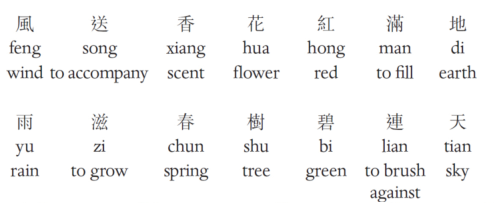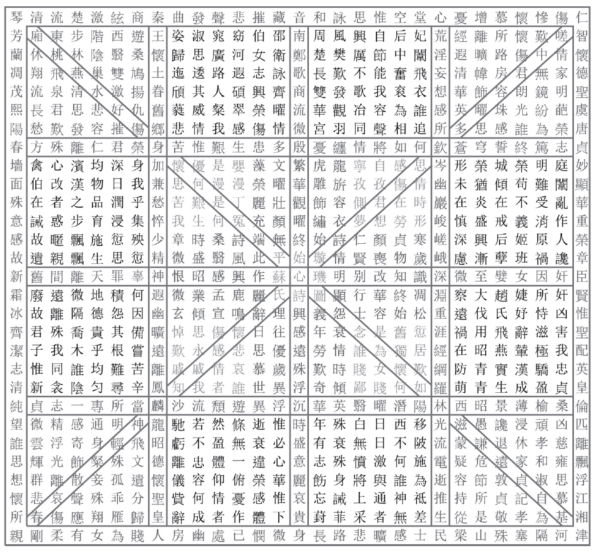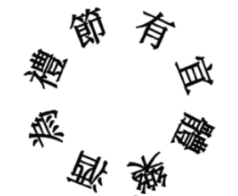created, $=dv.current().file.ctime & modified, =this.modified
tags: Poetry
The genre was known as the “flight of wild geese,” and the poems were often symbolically or literally sent to a distant lover, in the hope that he or she, like the migrating birds, would return.
The moon is round and so is the poem - Zhou Mengdie

huiwen poetic tradition - hui meaning “to return, revolve, circle, cycle” wen meaning “writing, language, text, culture” and when stitched together huiwen is translated “reversible, palindromic, anacyclical, circular, palin-textual” and refers to any text that is syntactically and semantically reversible.
For example “I love mommy” → “mommy loves me”
Wang Rong’s ten-line, five-character-per-line poem “Spring Stroll” in this volume exemplifies this kind of aesthetic accomplishment. Its forward reading moves from the woman’s thoughts of her beloved far out on the frontier, past twirling catkins, flowering groves, pond lotuses, the brocade curtain, and finally closes in on her aching presence in the inner chamber. In reverse her thoughts wander out in search for her beloved, from the inner chamber beyond the eastern pass north to the frontier. The two readings form an endless cycle of longing that returns and departs, zooming in and out, without ever reaching the object of her desire.
On Geese: rel:V Formation
Migrating wild geese often appear in classical Chinese poetry as a key trope (among many collective tropes) for messengers carrying letters between faraway lovers, family, or friends. They symbolize lovesickness, the loneliness and longing of exile, the sorrow of parting and separation, and the passing of the seasons as year after year the flocking waterfowl fly back and forth between their breeding and wintering grounds. Their flying formations write figures in the sky. Their route of departure and return may be the same, but the landscape beneath them changes.
Oulipo and Michele Metail interlude
Oulipo situated itself somewhere between the Surrealists and the secret society of mathematicians.
Fluxus: NY-conceived arts movement, intermedia/chance/performance with a turn toward the neo-Dada dance Outlipo: constraint/anti-chance/mathematics with a turn towards neo-Pythagorean texts (or possibly neo-Houdinian, “An Oulipian author is a rat who himself builds the maze from which he sets out to escape”)
rel:Radical Fiber - Threads Connecting Art and Science
Optantian, exiled and later recalled by Constantine the Great, also wrote a few carmina figurata (shaped visual poems) as well color-coded grid poems with versus intexti (“woven verses” i.e. secondary lines or poems inscribed in the text) that encode other poems vertically, horizontally, or diagonally, while also forming a third layer of reading as certain lines shape another set of letters within the grid. Optantian wrote: “It is a marvelous task for the mind to plait a poem in verse along various paths.”
After exhaustion of the generative power of traditional constraints they felt only mathematics could offer a way out between a nostalgic obstinacy with worn-out modes of expression and an intellectually pathetic belief in “total freedom”.
Those dead writers who wrote “paleo-Oulipian texts,” wholly unaware of the group’s existence, are called “anticipatory plagiarists.”
On Perec’s large palindromic poem: “Knowledge of the constraint disarms critical faculties; when you know that it is a monster palindrome, you tend to see nothing but its palindromic design”
A Certain Predisposition in the Language
wenyan - an ancient language reserved for philosophical and literary writing is characterized by extreme concision and the great capacity for evocation. The later is due to many polysemous words and relative imprecision. Punctuation does not exist and line breaks follow metrical and rhythmic criteria. The juxtaposition of invariable elements thus lends itself to reading in many directions.
Parallel sentence: a text in two lines, generally placed on each side of a door or decorative element.
 The wind accompanies the scented flowers, red, they cover the earth
The rain (makes) grow the spring trees, green, they brush against the sky
Reversed:
The sky brushes against the green trees, abundant spring rain
The earth covers itself with red flowers, wind full of scent
The wind accompanies the scented flowers, red, they cover the earth
The rain (makes) grow the spring trees, green, they brush against the sky
Reversed:
The sky brushes against the green trees, abundant spring rain
The earth covers itself with red flowers, wind full of scent
NOTE
This is important!
All poems thus play on this very broadened perception that combines image, sound, and meaning. Translation reconstructs only an impoverished paraphrase of a meaning that must be definitively and sometimes arbitrarily fixed at the cost of the characters’ formidable power of suggestion.
Origins
One of the first theoretical works on literature, The Literary Mind and the Carving of Dragons mentioned reversible texts “with many repetitions, he increases the impression of sadness.”
Anonymous Han Period Poem
xing xing chong xing xing to walk to walk again to walk to walk
Labyrinth


Su Shi, who was thinking of him, embroidered a reversible poem in the form of a map and gave it to him as a present.
armillary sphere:
Mortified, Su Shi felt hatred and regret. Thus she embroidered the reversible poem. Five colors were intertwined; it was a treasure for the heart, a splendor for the eyes. This brocade measured eight inches long by eight inches wide, more than two hundred poems were inscribed there, and one may count more than eight hundred words. Read vertically and horizontally, turned in one direction and then another, all ways offered poems. The characters were flawless and the delicacy of talent surpassed any that had existed since Antiquity. It is called “Map of the Armillary Sphere.” Nevertheless the reader cannot entirely grasp it. Su Shi laughed and said to people: “The poems are composed by moving about in all directions, but no one except the man I prize can understand it.” She sent a servant to take it to Xianyang. Tao read the embroidered characters with great attention. He found it to be a wonder without equal, and thus sent Yangtai back to Guanzhong. With great ceremony he had a carriage prepared to fetch Su Shi and bring her to Hannan. Their mutual love was thus reinforced.
The Cosmological Foundations of the Poems
Thought
Ok, so I haven’t read this segment yet but it conjured an interesting thought. In the above, what if the reading is reflected in the reading of the sky? As in particular configurations of the night’s starry sky can “unlock” the correct parse/read of the text, like a kind of cross reference which allows the eye to see through the noise and know which way to read.
In fact, the armillary sphere was used in astronomy to simulate the movement of the stars, thanks to movable concentric circles.
the map of the heart in the middle of the void
The central meridian is itself composed of fourteen characters on each side, and the interior meridian of four times four characters, with what the commentators call, “the map of the heart in the middle of the void” at the center. This is the central point of the poem. It is equivalent to the location of an equatorial telescope in the armillary sphere and it symbolizes the fixed point around which the celestial globe turns, in other words, the North Star.
Each part of the three-dimensional sphere thus finds its equivalent in this flat representation.
A Poem In Colors
The poem was mentioned to be originally in color


Poems in purple
The first way of reading:
To think of you calms me Sadness my feeling. Often I am by your side This dream tires my body.
The second way: My body is tired, I would like to dream When I was by your side. My feeling is only sadness I prefer to be alone to think of it.
&: I prefer to be alone to think To dream tires my body. When I was by your side Sadness my feeling.
&:
Sadness my feeling
I prefer to be alone to think of it.
To dream tires my body
When I am by your side.

Yin Zhongkan (5th Century)
Produces 16 readings. (Varying start position, forward/reverse)

- The rule is to have what suits the body Joy and wine which becomes ritual.
- Wine is the ritual rule Having what suits, the body is joyous.
- What delights the body, it is suitable to have it What rules the rituals, it is wine.
- What suits the body is joy and wine For rituals, there are rules.
Tang
The Tang Dynasty is rightly considered the golden age of Chinese poetry. The country was unified and lived in peace and prosperity. All the arts—painting, calligraphy, sculpture, architecture—experienced unprecedented developments and poetry evolved toward the so-called modern style, which took into account recent discoveries with regard to phonology: that is, the various tones of the language. These tones were grouped into two categories: the flat tone and the oblique tone, which were alternated according to rules then introduced in poetry, especially in quatrains and octets of five- or seven-syllable lines. The earlier forms of poetry continued nevertheless, and titles often mentioned “the ancient style.”